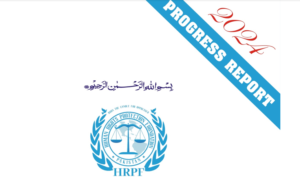Health Status Report of Sialkot (January 2024 – April 2024)
Prepared by: Secretary General, Human Rights Protection Foundation
Date: 31-05-2024
Introduction:
The Human Rights Protection Foundation (HRPF) requested information under The Right To Information Act, 2013 from the Chief Executive Officer of the District Health Authority, Sialkot. This report outlines the health and disease conditions in various regions of Sialkot based on data collected from January 2024 to April 2024. The purpose of this report is to analyze and highlight significant trends, and to raise concerns regarding the health status in the district.
Data Summary:
The following data was provided by the District Health Authority, Sialkot:
– Pneumonia: 932 cases
– Chronic Obstructive Pulmonary Disease (COPD): 14,065 cases
– Seasonal Influenza: 10 cases
– Cutaneous Leishmaniasis: 5 cases
– Gastroenteritis: 28,805 cases
– Bloody Diarrhea: 1,892 cases
– Typhoid Fever: 1,681 cases
– Trachoma: 439 cases
– Glaucoma: 441 cases
– Acute Conjunctivitis: 785 cases
– Goiter: 137 cases
– Epilepsy: 86 cases
– Dog Bite: 326 cases
– HIV/AIDS: 1 case
– Stroke: 1,056 cases
Analysis and Concerns:
1.Gastroenteritis (28,805 cases):
– The extremely high number of gastroenteritis cases is alarming and indicates potential issues with water and food sanitation in the region.
– Immediate steps are necessary to assess and improve water quality and food safety measures.
- Chronic Obstructive Pulmonary Disease (COPD) (14,065 cases):
– The high prevalence of COPD cases suggests significant air quality issues, potentially linked to industrial pollution or high smoking rates.
– Implementation of air pollution control measures and anti-smoking campaigns could be beneficial.
- Pneumonia (932 cases) and Seasonal Influenza (10 cases):
– Respiratory infections continue to be a concern, especially among vulnerable populations such as the elderly and children.
– Strengthening vaccination programs and public health campaigns on respiratory hygiene are recommended.
- Typhoid Fever (1,681 cases) and Bloody Diarrhea (1,892 cases):
– There is a pressing need to address issues related to clean drinking water and overall sanitation.
– Establishing better sewage systems and promoting hygiene practices can help reduce these numbers.
- Trachoma (439 cases) and Glaucoma (441 cases):
– Eye health appears to be a significant concern, with a notable number of cases concerning preventable or treatable conditions.
– Initiatives for regular eye check-ups and public awareness campaigns on eye care should be considered.
- Cutaneous Leishmaniasis (5 cases):
– Although the number of cases is relatively low, it indicates the presence of disease vectors such as sandflies in the region.
– Vector control programs and public education on preventive measures are essential.
- Stroke (1,056 cases) and Epilepsy (86 cases):
– Neurological conditions, including strokes, indicate the need for better management of lifestyle diseases like hypertension and diabetes.
– Integrating neurological care into primary health care and screening programs is critical.
- Dog Bite (326 cases):
– Rabies risk linked to dog bites necessitates better control of stray dog populations and public education on rabies prevention.
– Vaccination programs for dogs and rapid response initiatives for dog bite incidents should be strengthened.
- HIV/AIDS (1 case):
– Even though there is only one reported case of HIV/AIDS, continuous efforts in awareness, testing, and counseling services are vital to prevent further spread.
Recommendations:
- Enhance water and sanitation infrastructure to reduce cases of gastroenteritis, typhoid fever, and diarrhea.
- Implement stricter air quality control measures and conduct public health awareness campaigns to combat COPD and other respiratory diseases.
- Promote and provide vaccinations and public health education to minimize the impact of infectious diseases like pneumonia and influenza.
- Launch targeted health programs focusing on eye care and regular screenings for conditions like trachoma and glaucoma.
- Improve the management and control of neurological disorders through primary health care integration and public awareness.
- Strengthen vector control programs and public education on the prevention of diseases like Cutaneous Leishmaniasis.
- Enhance rabies vaccination programs for both the human population and stray dogs, coupled with public awareness campaigns on dog bite prevention and treatment.
- Maintain and expand programs for regular HIV/AIDS testing and counselling to ensure early detection and prevention.
Conclusion:
The health data from January 2024 to April 2024 reveals several pressing public health challenges in the Sialkot region. The high prevalence of gastroenteritis, COPD, and waterborne diseases, in particular, warrants immediate attention. Addressing these concerns through improved sanitation, air quality control, vaccination drives, and educational programs will be crucial to enhancing the overall health status of Sialkot residents.
Action Required:
We urge the District Health Authority to prioritize resources and interventions targeting these critical health issues. By working together, we can foster a healthier environment and significantly reduce the burden of disease in the Sialkot region.
Attachments:
– Detailed Health Data (January 2024 – April 2024)
Signature:
Dr. Iqra Mubashar
Secretary General, Human Rights Protection Foundation
—





